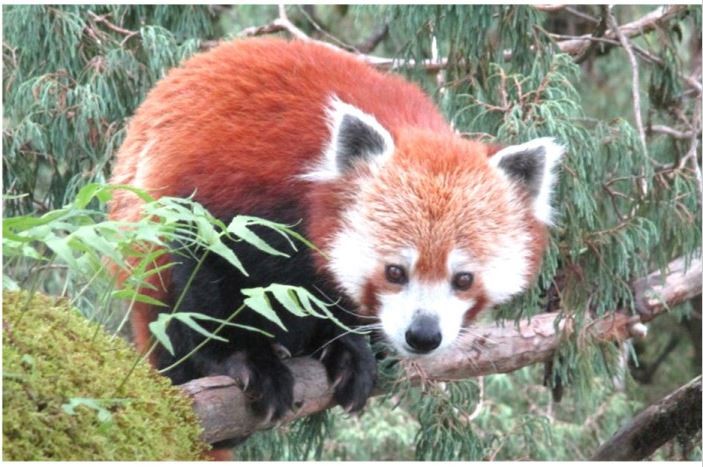Status of Red Panda in Nepal

Pratik Bhattarai
Red panda is enlisted in the endangered category of the IUCN Red List of threatened species in the world. In the context of Nepal, among the 27 endangered protected mammals, red panda is considered one of the most valuable species. This shy, cryptic and elusive animal is also included in the Appendix – I of the Convention on International Trade in Endangered species of Wild Flora and Fauna (CITES).
With less than ten thousand Red Pandas left in the world, they are on the verge of extinction in the near future. Climate change, deforestation, habitat degradation, poaching, illegal trade, and hunting are the major factors contributing to their dwindling population. In Asia, their existence is reported in India, Nepal, China, Bhutan, and Myanmar.
Red Panda has its distribution in Temperate and Sub-Alpine forest from the elevation ranging from 2200-4800m in Nepal. They have been protected in Rara, Shey- Phoksundo, Langtang, Sagarmatha, and Makalu Barun National Park. They are also protected in Annapurna, Manaslu, Gaurishankar, and Kanchanjunga Conservation Areas. The major distribution that lies inside and outside the protected area includes Ilam, Panchthar, Taplejung, Khotang, Solukhumbu in the east and Rolpa, Western Rukum, Jumla, Dolpa, Mugu and Kalikot in the west.
The red panda subspecies Ailurus fulgens fulgens is primarily found in Nepal. It is small, crepuscular about the size of a house cat arboreal mammal that lives in the temperate forest Their habitats are forests with Nigalo (Arundinaria maling) which are small-statured bamboo found in the upper part of Eastern and Mid- Western Nepal. Thus, conservation of the Nigalo forest is vital for the conservation of Red Panda. They spend most of the time alone sleeping on a tree branch or in tree hollows during the day.
Bamboo leaves and shoot constitute more than 80 per cent of their diet. They also forage on the leaves and berries of plants Arundinaria maling Quercus semicarpifolia, Juniperus species, Rhododendron companulatum, bird eggs and small insects. The estimated number of red panda is around 1,000 in Nepal and according to the Red Panda Network survey conducted in June/ July 625 red panda fecal samples have been identified and cataloged. According to Red Panda Network, red pandas are found in 23 districts of Nepal.
The establishment of Protected Areas in the Mountain Region is contributing to red panda conservation to some extent. Community-based conservation agencies and district forest offices are implementing Red Panda conservation programmes. Experts who can handle GPS and camera traps are involved in their survey, monitoring, and evaluation.
Red Panda Network (RPN) has been a pioneer organisation working for endangered red panda conservation in Nepal. RPN is addressing poverty with livelihood improvement and alternative income initiatives which include ecotourism, organic farming, micro-enterprises, an anti-poaching network. Different NGOs and INGOs are involved in awareness programmes at the community and school levels.
Illegal hunting for their fur, meat and other body parts, overgrazing, deforestation, and climate-induced disasters are some of the challenges in their conservation. Till date, the red panda has not been reported with any sort of conflict with the local people. So it is easier to convince the local people to get involved in their conservation. This animal can promote ecotourism which can provide an extra source of income for the local communities and help to uplift their living standard.
The government has introduced The Red Panda Action Plan (2019-2023) to improve the status of Red Panda and secure its habitat against existing threats. This action plan focuses on conducting research, implementing scientific tools and techniques and creating a suitable habitat for them. It emphasises controlling illegal hunting and strengthening the local community for red panda conservation. Section 26 of the NPWC Act, 1973 provisions a fine ranging from Rs. 500,000 to Rs. 1,000,000 or an imprisonment of 5 to 15 years or both for the offenders and illegal trade in red panda and its body parts. The act has provision to give cash reward of Rs. 25,000 for aiding in seizure of its parts or arrest of such criminals.
Besides state and local governments, buffer zone management committee, community-based organisations, community forest user groups, security forces and local people have to play a significant role for red panda conservation.
(Bhattarai is an Undergraduate student at the Institute
Of Forestry, Pokhara.)
Recent News

Do not make expressions casting dout on election: EC
14 Apr, 2022
CM Bhatta says may New Year 2079 BS inspire positive thinking
14 Apr, 2022
Three new cases, 44 recoveries in 24 hours
14 Apr, 2022
689 climbers of 84 teams so far acquire permits for climbing various peaks this spring season
14 Apr, 2022
How the rising cost of living crisis is impacting Nepal
14 Apr, 2022
US military confirms an interstellar meteor collided with Earth
14 Apr, 2022
Valneva Covid vaccine approved for use in UK
14 Apr, 2022
Chair Prachanda highlights need of unity among Maoist, Communist forces
14 Apr, 2022
Ranbir Kapoor and Alia Bhatt: Bollywood toasts star couple on wedding
14 Apr, 2022
President Bhandari confers decorations (Photo Feature)
14 Apr, 2022











